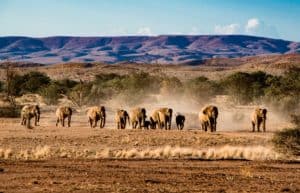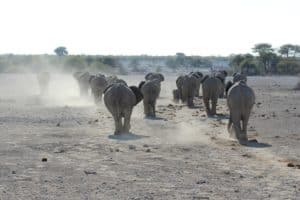Most of us know elephants can broadly be classified into African and Indian, but there are actually three species, the African bush (or Savannah) elephant, the African forest elephant, and the Asian elephant.
By our comms queen Anna Waddington-Feather
I’ve always had a ‘thing’ about these magnificent animals. Just ask my mother whose artistic skills were put to the test when I was aged 6; all I wanted for my 7th birthday was a poster of an elephant and she was unable to find a suitable one in the shops.….
While I don’t claim to be an elephant expert, I do like to think I know my bushes from my forests.
So how do you tell them apart?
The easiest way to tell the difference between African and Indian elephants is their rather noticeable ears; African ones have large ears, conveniently shaped like the African continent, while the Asian’s ears are smaller and conveniently shaped like India!
When it comes to the subspecies, the devil is in the detail…..
In our destinations, Namibia and Gabon you can see three types of elephants. In Namibia, you can see two subspecies of the bush elephant, while in Gabon you can see forest elephants.
Desert elephants in Namibia
 With their broader feet and longer legs, these animals have adapted to their harsh surroundings of desert life. They also tend to have relatively smaller bodies than other African bush elephants too. As they eat moisture-laden vegetation growing in ephemeral riverbeds, they are able to go without drinking water for several days in extreme circumstances. Interestingly, researchers have found they destroy fewer trees than elephants living in areas of Africa with higher rainfall.
With their broader feet and longer legs, these animals have adapted to their harsh surroundings of desert life. They also tend to have relatively smaller bodies than other African bush elephants too. As they eat moisture-laden vegetation growing in ephemeral riverbeds, they are able to go without drinking water for several days in extreme circumstances. Interestingly, researchers have found they destroy fewer trees than elephants living in areas of Africa with higher rainfall.
If you want to look for desert elephants, head out to the sandy desert, rocky mountains and arid gravel plains of the Kunene Region, in Namibia’s northwest. Contact Emma for your bespoke Namibian elephant adventure!
South African bush elephants in Namibia
 These elephants are the largest existing land mammals, with males standing at over 3m at the shoulder.
These elephants are the largest existing land mammals, with males standing at over 3m at the shoulder.
They have large ears and long curving tusks; one feature which sets the African bush elephant apart is its upper lip is composed of two extensions.
The African bush elephant can be seen in established national parks and reserves such as the Etosha National Park.
You can see these animals, and many more on our Namibia wildlife and self-drive holiday.
Forest elephants in Gabon
 Initially thought to be a sub-species of the bush elephant, research has revealed forest elephants are actually a species in their own right. With a shoulder height of around 2.4m, they are the smallest of the elephant species. They tend to have straighter tusks and more rounded ears than their bush elephant relatives, and, unlike their bush elephant relatives, they have five toenails on the fore foot and four on the hind foot.
Initially thought to be a sub-species of the bush elephant, research has revealed forest elephants are actually a species in their own right. With a shoulder height of around 2.4m, they are the smallest of the elephant species. They tend to have straighter tusks and more rounded ears than their bush elephant relatives, and, unlike their bush elephant relatives, they have five toenails on the fore foot and four on the hind foot.
And their most distinguishing feature are their beady yellow eyes!
Why not search for these, gorillas, surfing hippos and other animals on our Gabon wildlife experience suggested itinerary?
Elephants are of high national (for both countries) and international conservation priority, and are on the IUCN (International Union for the Conservation of Nature) Red List for protection.
Find out more
Ian knows all about Namibia, and both Ian and Max are our Gabon specialists. Give them a call to create your African adventure on 01768 721040, or drop them a line via our contact form. (But if you want to know more about elephants, ask for Anna!)
7 more elephant facts you may not know:
 – they are either left or right tusked
– they are either left or right tusked
– their trunks have more than 40,000 muscles, enabling them to pick up anything, from huge logs to a tiny grain of rice
– the closest living relative to elephants are hyraxes – a small, thickset, herbivorous mammal often mistaken for a rodent
– elephants have sensory cells in their feet and can detect seismic signals
– they excrete around 1 tonne of tonne of dung each week (but that’s OK, because elephant dung has some unexpected uses)
– France’s Louis IX gave Kind Henry III, (who ruled England from 1207 to 1272), an elephant. The animal only lived for two years, and it reportedly died from drinking too much red wine!
– because an elephant’s lifespan is similar to a humans and they have surprisingly low rates of cancer for a creature of their size, scientists are researching their genes to help find a cure for cancer in humans.

